Text

Inheritance, by Nora Roberts
A perfect blend of wish-fulfillment fantasy, romance, and deliciously spooky atmosphere
Inheritance, the first book in Nora Roberts’s Lost Brides trilogy, provides the perfect blend of wish-fulfillment, friendship, romance, and spookiness. I loved Sonya, the main character, a spirited, entrepreneurial graphic designer who uproots her life to live in the historic manor she unexpectedly inherits on the Maine shoreline. I loved the friendly ghosts she tries so hard not to believe in, and the adorable dog she adopts (his name is Yoda!) The young lawyer, Trey, is as easy to like as he is on the eyes. His family, as well as Sonya’s newly-met cousin Owen and her best friend Cleo, are all likeable and sympathetic. Cleo in particular is delightful, and I have high hopes for a secondary romance between Cleo and Owen.
On the other hand, the malevolent ghost who haunts the mansion and intermittently threatens Sonya? She gives me chills. But just the right amount of chills to thrill, and not so many as to cause nightmares. (At least not yet. I have a feeling things may escalate in the second and third books.)
The publisher’s blurb summarizes the plot of Inheritance pretty well. Sonya hasn’t just inherited a gorgeous-but-haunted mansion, she has also inherited a family curse going back generations. And she’ll have to solve a family mystery and break the curse if she doesn’t want to become this generation’s victim.
One of the things I appreciate about Nora Roberts, particularly in the past 15 years or so, is that the suspense plot doesn’t drive the entire book or dominate the main character’s life to the exclusion of all else. Instead, Roberts’s books spend plenty of time developing the character and the character’s day-to-day life. Just like people facing challenges in real life, Roberts’s characters have to live their lives between, around, and despite whatever dangers they face. For Sonya, that means settling into the mansion, meeting and learning more about her own family, exploring her growing relationship with Trey, and getting to know the small town and its people. She’s building a life here, and that process is part of her character arc; it’s also Roberts’s way of creating the support network Sonya will need as the supernatural threat against her grows.
Another thing I appreciated is the “competence p*rn,” as Sarah from SBTB calls it. Everyone in this book—everyone who matters, that is—both enjoys and is extremely good at what they do. None of the sympathetic characters are unhappy in their job or struggling with self-doubt; no one is even merely mediocre. It’s refreshing, though perhaps a little intimidating for those of us who, well into into our adulthood, are still figuring out what we want to be when we grow up.
All in all, there’s not a single thing I would change about this book — not even the cliffhanger ending. Which, I’ll be honest, is not something I ever thought I would say. Normally I hate cliffhanger endings, but in this case I’m not really sure how else the book could have ended. That said, if you can’t stand cliffhangers, you should probably wait to read Inheritance until the second book comes out, or maybe even the third. Because this book? It will definitely leave you in suspense.
Challenges: Library Love Challenge 2024
Review originally published on The Bookwyrm's Hoard blog, 4/04/2024.
#book review#my reviews#nora roberts#lost brides trilogy#books#ghost stories#romance#contemporary romance
2 notes
·
View notes
Text
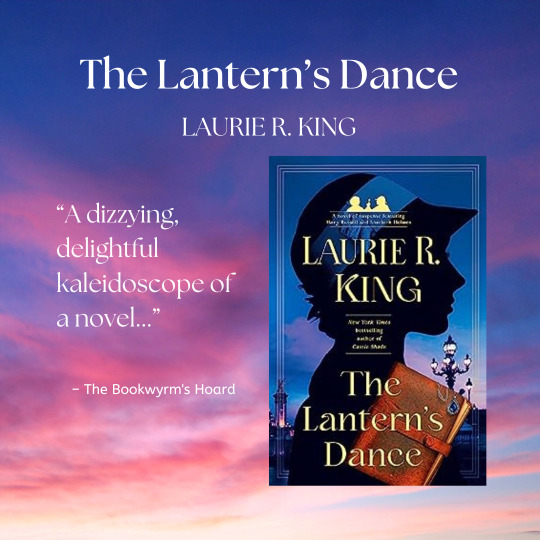
The Lantern’s Dance, by Laurie R. King
A dizzying, delightful kaleidoscope of a novel
I was very excited to read The Lantern’s Dance, the first new Mary Russell & Sherlock Holmes mystery since 2021’s Castle Shade. Once started, I could hardly put it down, staying up until 2:30 in the morning to reach the denouement. Like The Murder of Mary Russell, the novel alternates between past and present narratives, slowly revealing hidden connections that surprised and enchanted me.
Readers familiar with the Sherlock Holmes canon may recall that in “The Adventure of the Greek Interpreter,” Holmes divulges that his grandmother was “the sister of Vernet, the French artist”—probably Horace Vernert (though the Vernet family produced a number of artists through the generations.) From this single quotation and a few other tidbits about Holmes’s origins, Laurie R. King has woven an adventure involving an antique zoetrope, a coded journal, family secrets, missing jewels, and a thirst for revenge several generations in the making. Told from three points of view (Mary Russell, Holmes, and the journal’s author), The Lantern’s Dance is a dizzying, delightful kaleidoscope of a novel, where each new revelation paints the known facts in a different light.
The book begins with Russell and Holmes arriving at Holmes’s son Damian’s home in France, only to discover that the Adlers (Damian, his fiancée Dr. Aileen Hemmings, and his young daughter Estelle) have fled. On questioning the neighbors, Holmes and Mary learn that several foreign men, possibly Indians, have been seeking Damian for several weeks—around the same time that he received a trio of crates and a trunk once belonging to the artist Vernet. A break-in the previous night by a man dressed as a lascar (an Indian sailor) has sent the Adler family into hiding. Holmes immediately sets out to find and protect them, while Russell, hobbled by a sprained ankle, remains at the Adler home to explore the crates and see what can be learned locally. Discovering an old journal written in an obscure and fiendishly difficult code, she sets about decoding it. As she reads, Mary begins to suspect the journal is connected not only to the Vernet family, but to the present-day mystery and perhaps even to Holmes himself.
If I have any small quibble about the book, it’s that I would have liked to see more of the present-day Adlers, particularly the child. The short glimpses of her are as charming as her appearances in The God of the Hive, but far too few. I also would have enjoyed more interactions between Damian and Aileen, and between Damian and his father… though their few interchanges are handled well, and I appreciate the hints of growth in their relationship with one another. Still, this is first and foremost a Mary Russell novel; while we do spend time with Holmes, the focus leans toward both Mary and the journal.
The chapters rotate between the three points of view, with the journal chapters often followed by Mary’s thoughts on what she has translated thus far, and her own attempts to find out more about the men seeking Damian. This sometimes makes for slightly uneven pacing, but on the whole, King build the tension well. My only other quibble is that in one of the plotlines, the danger is overcome a little too easily and the tension fizzles out. But this is not, strictly speaking, a murder mystery; it’s more a series of puzzles both past and present, and the reader has all the fun of figuring out not only the solutions (who are the men seeking Damian, and why? Who is the mysterious journal writer?) but also how they may be connected. I did in fact manage to solve the majority of the interlocking puzzles myself, but I missed a few crucial pieces here and there, and therefore I thoroughly enjoyed the final denouement.
I recommend The Lantern’s Dance to all of Mary Russell’s many fans—you won’t be disappointed! But if you’ve never met Russell or Laurie King’s iteration of Holmes before, you should really start with the first book in the series, The Beekeeper’s Apprentice, and follow that up with (at a minimum) the short story “The Marriage of Mary Russell” and the two-part mystery contained in The Language of Bees and The God of the Hive; the last two give necessary background on Damian, Estelle (also known as Stella), and Aileen. But honestly, I urge you to read the entire series in order; it’s one of my favorite mystery series of all time, and the order actually does matter.
Challenges: NetGalley & Edelweiss Challenge 2024; COYER Unwind (2024), Chapter 1; COYER Readathon (Read a book from a friend’s list)
Review originally published on my blog, The Bookwyrm's Hoard.
FTC disclosure: I received a review copy from the publisher. All opinions are entirely my own.
#book review#my reviews#historical mystery#mystery#mysteries#laurie r king#mary russell#sherlock holmes
0 notes
Text

Legends & Lattes, by Travis Baldree
Heartwarming cozy fantasy
What can I say about Legends & Lattes that hasn’t already been said? Baldree’s breakout, bestselling debut novel hits the sweet spot for me: low-stakes cozy fantasy, found family, believable (and likeable) main character, interesting secondary characters, and solid worldbuilding with a D&D feel. It’s a well-crafted novel with good pacing and just the right amount of description…enough to bring the scenes vividly to life without overwhelming the action or Viv’s emotional journey.
Speaking of Viv, I almost didn’t read the book because my concept of orcs is decidedly influenced by Tolkien, who in turn was influenced by George MacDonald’s goblins (with which I’m also familiar.) In other words, I was put off by the mere idea of an orc as a main character. (More fool me; I should know better than to judge based on stereotypes, even in fiction!) But between the internet buzz, the delightful cover art, and the seemingly unlikely premise—an orc mercenary retiring to open a… coffee shop?!—I decided to give it a try, and I’m so glad I did. I fell hard for Viv and her newfound friends, for her respect for others regardless of species, and for the warmth and welcoming atmosphere of the Legends & Lattes café.
And omg, the food! I can’t read the book without craving cinnamon rolls, chocolate croissants, biscotti, and (since I can’t drink coffee) a decaf chai latte to go with them.
I love Legends & Lattes so much, it has joined the ranks of my rereadable “comfort books,” and I have already read it twice. I can’t wait to read the prequel, Bookshops & Bonedust!
Review originally published on my blog, The Bookwyrm's Hoard.
FTC disclosure: I received a review copy from the publisher, but later bought my own copy. All opinions are entirely my own.*
0 notes
Text
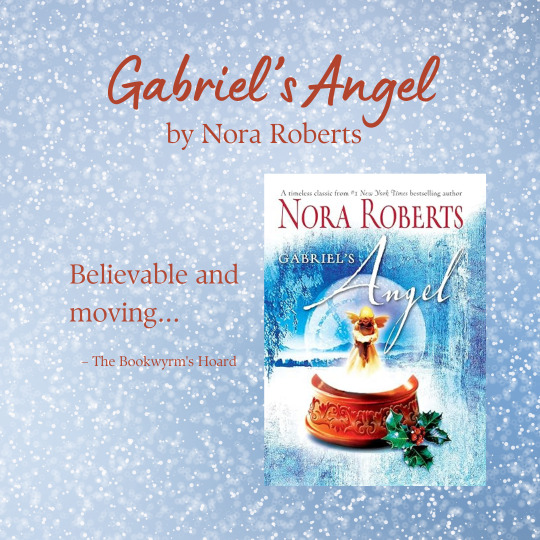
Gabriel's Angel, by Nora Roberts
Gabriel’s Angel is an example of just how good category romance can be when it’s done well, within the strict confines of length and style imposed by the publisher. Gabriel, a reclusive artist on the run from grief, and Laura, a woman trying desperately to protect her unborn child, are both in pain from events in their recent pasts. Each needs something the other can give: inspiration, protection, understanding, healing. Their marriage may be one of convenience, but the attraction between them is real from the beginning, and the blooming of their feelings is believable. The well-worn plot device of the pregnant-woman-on-the-run works very well in Roberts’s capable hands; she manages to keep it from being a cliché, and doesn’t flinch from the realities of the abuse Laura suffered at the hands of her first husband. Both Laura and Gabriel find strength and healing through the other’s care and support, as well as through seeing them interact with baby Michael; their growth is also believable and moving. The ultimate resolution of Laura’s predicament, though it plays out across several scenes, was more than satisfying; I wanted to cheer when she finally stood up to her antagonist.
Gabriel’s Angel was originally a Silhouette novel (published in 1989), and those length limits I mentioned above are evident when you compare the book with Roberts’s non-category romances. Although I enjoyed the novel, I missed the depth; the wealth of vivid, everyday detail; the more complicated plot; and the complex, well-realized protagonists that are all characteristic of Roberts’s later, longer books.
Challenges: The Backlist Reader Challenge 2024
0 notes
Text

Why Fish Don't Exist, by Lulu Miller
Why Fish Don’t Exist is a short but well-written and captivating book which combines biography, memoir, science (particularly taxonomy), and philosophy. Written by Lulu Miller, who cohosts both RadioLab and NPR’s Invisibilia podcast, the book recounts Miller’s fascination and subsequent disillusionment with David Starr Jordan, a prominent scientist and scholar during the late 19th and early 20th century. An ichthyologist, passionate about taxonomy, Jordan rose to become the first president of Stanford University and, following his retirement, an outspoken advocate for peace. But as Miller shares her discoveries about Jordan with the reader, a darker side of the man emerges.
Miller’s writing is engaging, even poetic at times, and she certainly knows how to tell a story. She punctuates the biographical chapters with sections on her own life and her struggle to find meaning and order in a universe where chaos reigns supreme. Despite some darker sections*, it’s ultimately a hopeful book, and one I am glad to have read.
*CW: Sensitive readers should be aware that the book includes discussions of some difficult topics, including suicidal ideation, eugenics, and possible murder.
#why fish don't exist#lulu miller#books#audiobook#book review#my reviews#science#memoir#biography#taxonomy
1 note
·
View note
Text

My Most Anticipated New Releases for January–June 2024
Emily Wilde’s Map of the Otherlands by Heather Fawcett (Jan. 16, 2024)
The Lily of Ludgate Hill by Mimi Matthews (Jan. 16, 2024)
Just Stab Me Now by Jill Bearup (Feb. 5, 2024)
Perfect Accord by Celia Lake (Feb. 9, 2024)
The Lantern’s Dance by Laurie R. King (Feb. 13, 2024)
Speculations in Sin by Jennifer Ashley (Mar. 5, 2024)
A Grave Robbery by Deanna Raybourn (Mar. 12, 2024)
A Midnight Puzzle by Gigi Pandian (Mar. 19, 2024)
The Hidden City by Charles Finch (May 6, 2024)
People in Glass Houses by Jayne Castle (May 7, 2024)
Mind Games by Nora Roberts (May 21, 2024)
The Magic of Four by Celia Lake (May, 2024 — date TBD; no link or cover available. Cover shown is just a placeholder.)
Smoke and Mirrors by M. E. Hilliard (June 4, 2024 — slipped from Feb. 2024)
A Collection of Lies by Connie Berry (June 18, 2024)
Honorable Mention (or) Already Read
A Fragile Enchantment by Allison Saft (Jan. 2, 2024; currently reading)
The Night Island by Jayne Ann Krentz (Jan. 9, 2024; read and reviewed)
Always Remember by Mary Balogh (Jan. 16, 2024; read and reviewed)
The Bright Spot by Jill Shalvis (Jan. 16, 2024)
Of Hoaxes and Homicide by Anastasia Hastings (Jan. 30, 2024)
The Tainted Cup by Robert Jackson Bennett (Feb. 6, 2024)
The Book of Doors by Gareth Brown (Feb. 13, 2024)
Floating Hotel by Grace Curtis (Mar. 19, 2024)
Dragon Rider by Taran Matharu (Apr. 2, 2024)
A Letter to the Luminous Deep by Sylvie Cathrall (Apr. 25, 2024)
Twelfth Knight by Alexene Farol Follmuth (June 18, 2024)
1 note
·
View note
Text
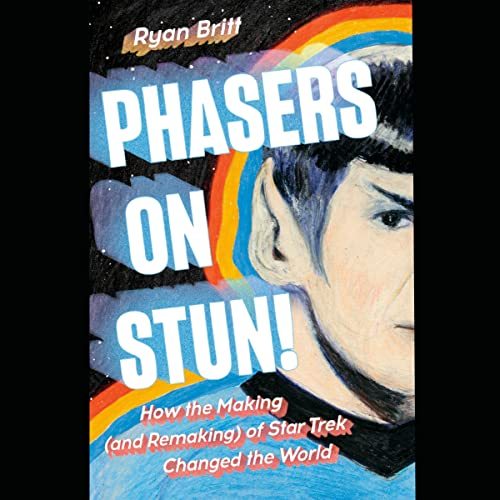
Phasers on Stun!: How the Making (and Remaking) of Star Trek Changed the World, by Ryan Britt
Informative, entertaining, and delightful
As a lifelong Star Trek fan, I found Phasers on Stun!: How the Making (and Remaking) of Star Trek Changed the World both very informative and highly entertaining. The book covered things I already knew (for example, how Martin Luther King, Jr., told Nichelle Nichols that she had to remain on the show) , but also went into depth on things I hadn’t known (like the extent to which Nichols was instrumental in getting NASA to diversify the astronaut program, and her subsequent recruiting on NASA’s behalf.)
Like me (and my husband, Mr. Bookwyrm), Ryan Britt is a fan not only of Trek in its many iterations, but also of the ideals and underlying beliefs of Star Trek: its optimism; its vision of a future where all intelligent beings are respected and included regardless of race, gender, sexual orientation, gender identity, or even species; and its preference for diplomatic resolution of conflicts (although Starfleet is willing to fight to defend its member planets when necessary.) Britt looks at how those ideals have been represented throughout the various series of Star Trek, from the original series (TOS) to Strange New Worlds. The shows haven’t always lived up to those ideals—it wasn’t until Discovery that a Star Trek series featured openly LGBTQIA+ characters as regulars, for instance—but from the beginning, the Enterprise crew, and by extension Starfleet and Star Trek itself, was diverse in terms of race, gender, and species. (I suspect the original Enterprise crew would have included more alien crew members if the show could have afforded them.) And while Star Trek’s example of embracing diversity is very much aligned with the liberal and Quaker values with which I was raised, TOS and ST:TNG both had a profound effect in shaping my worldview.
In telling the history of the shows and how they impacted and interacted with popular culture and real-world events, Britt includes quotes and stories from a number of Star Trek luminaries, from writers and showrunners to actors. Some of these are drawn from interviews conducted for various articles Britt (a sci-fi and pop-culture journalist) has written over the years; other interviews took place specifically for this book. The interviews and quotes give an insight into the experiences and motivations of the people who made and remade Star Trek, and continue to do so to this day.
Whether you grew up watching one of the Star Trek shows, came to the fandom as an adult, or simply want to understand the wide appeal of the Star Trek universe, I recommend reading or listening to Phasers on Stun! It’s a warm, loving, but not uncritical look at a pop-culture phenomenon that, at over 50 years old, is still relevant, influential, and dynamic.
8 notes
·
View notes
Text

Always Remember, by Mary Balogh
A beautiful strangers-to-friends-to-lovers story
Jennifer Arden, younger sister of the new Duke of Whilby (Remember Me), was crippled after a childhood disease left her with a twisted, shortened leg and foot. Deeply loved by her family, she is nonetheless an outsider rather than a participant in the ton, forced by her disability to sit quietly on the sidelines. She has cultivated a cheerful acceptance of her fate, but in her heart, she longs for romance, marriage, children… or simply to walk and dance like other young women.
Ben Ellis, the illegitimate son of the previous Earl of Stratton, knows all about being an outsider. Raised as a brother to the current Earl, Devin (Remember Love), and loved and accepted by his siblings and even their mother, Ben is nonetheless aware that his birth renders him ineligible to court any of the gently-born young ladies of his acquaintance.
On the surface, a match between Ben and Jennifer is impossible, but they are perfect for each other… if only they can find a way past the societal and family expectations that stand in their way.
Mary Balogh makes Ben and Jennifer’s journey to love and their families’ eventual acceptance both beautiful and moving. Their families’ objections arise out of their love for them both, but also from their unconscious beliefs regarding class and disability. Apart from one angry outburst by Jennifer’s brother Luc, both families’ opposition is quiet and caring, involving hints and subtle efforts to keep the pair apart. Their deep love for Ben and Jennifer enables their family members to eventually see and acknowledge how well-suited the couple are, and to gradually move from loving opposition to full support.
As her fans already know, Mary Balogh’s narrative voice is distinctive: quiet and more formal than most of the authors writing historical romance today. Her style suites the time period as much as it does the character-driven romances she writes. In Always Remember, she skillfully and sensitively depicts Ben’s complicated feelings about his parentage, his place in the Ware family, and his lack of knowledge about his birth mother. She is equally adept at unfolding Jennifer’s feelings about her disability and the effects of her family’s overprotectiveness. And the scenes showing Ben with his young daughter simply made my heart melt.
Both Ben and Jennifer love and appreciate their respective families, but each has consciously and unconsciously shaped themselves to fit their family’s expectations. The friendship between them develops because they are able to see and share with one another their hidden dreams, feelings, and needs. Jennifer and Ben see past not only the other’s social façade, but past the superficial obstacles—Ben’s illegitimacy, Jennifer’s disability—that initially kept them from noticing one another at all. As their friendship deepens, they encourage each other to acknowledge and explore their dreams: Jennifer’s for greater mobility and independence, and Ben’s to learn about and connect with his mother’s family. Ben’s approach to Jennifer’s disability is blessedly practical, figuring out ways to help her achieve more independence. Jennifer’s approach is more empathetic but equally helpful and insightful, given that Ben’s issues are more emotional and social than physical in nature.
I loved this strangers-to-friends-to-lovers story, and highly recommend it to Balogh’s fans and to lovers of well-written (and well-researched) historical romance generally. My only caveat is that the cast of secondary characters is enormous, and keeping track of them is made even more confusing by the use of titles or nicknames interchangeably with given names. For that reason, you should probably read the first two Ravenswood books before you read Always Remember; you will have a much easier time keeping track of who everyone is and how they are related. Even then, if you aren’t blessed with a genealogist’s memory for names and relationships, I suggest keeping a notebook handy to jot down the dramatis personae!
0 notes
Text
Why You Should Read Emily Wilde's Encyclopaedia of Faeries by Heather Fawcett

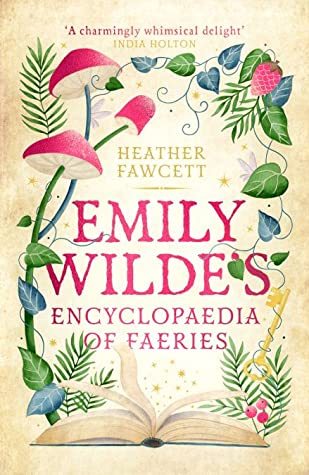
Emily, a Cambridge professor of dryadology travels to a remote Scandinavian town to study a previously unstudied type of faerie, in order to complete the Encycopaedia she is working on
When her colleague and academic rival, Wendall Brambleby also shows up, getting in her way and infuriating her, Emily and Wendall must work together to uncover the secrets of the faeries.
This book is like if Howls Moving Castle and Spinning Silver had a child?
Emily and Wendall give major Howl and Sophie vibes. Wendall is a dramatic, over the top sliterer-outer (and may not be all that he seems). Emily is a bit of a curmudgeon, not a people person, and dedicated to her work.
This book is a journal format, and we are reading Emily's journal recounting the experience
Footnotes!
This is a winter read through and through
Cozy-fantasy that is set during the Edwardian era, although parts can get a little bit dark (that's just how faeries are though)
the Faerie in this book reminded me a lot of the the staryk from Spinning Silver, so if you like that type of faerie, this book is for you
This book is a love letter to fairy tales, faeries, and folklore
A lovable dog companion, lesbian side characters
Changelings, brownies, Winter Kings and Faerie Princes, enchantments
This book is just clever and neat, and really opens up a lot of potential for other books
All in all, I loved it, and I think you should read it too!
994 notes
·
View notes
Text
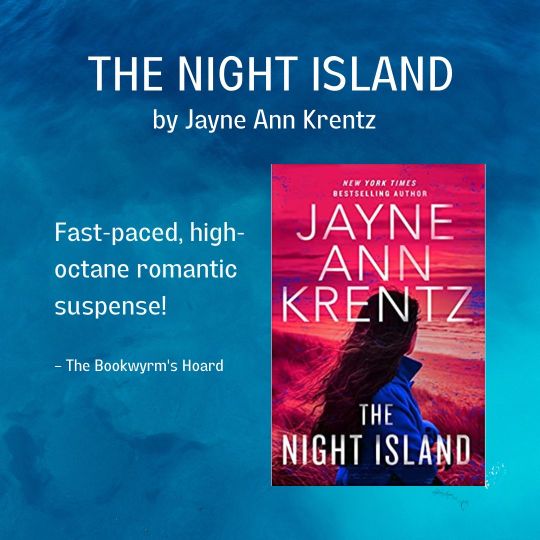
The Night Island, by Jayne Ann Krentz
Fast-paced, high-octane paranormal romantic suspense
(Note: This review contains spoilers for book #1 in the series, Sleep No More.)
I've been a fan of Jayne Ann Krentz's fast-paced, high-octane romantic suspense thrillers for years now, so I always look forward to the next one. The Night Island did not disappoint. In fact, the pacing is smoother than in the previous book in this series (Sleep No More), and the plot is easier to follow.
In Sleep No More, we learned that months earlier, three women (Pallas, Talia, and Amelia) had woken together, strapped to gurneys in a burning building, with no memories of the previous night... and with enhanced psychic abilities. Determined to find out what happened to them, they joined together to start The Lost Night Files podcast. Sleep No More recounts Pallas's investigation of someone else's missing night; she and the subject, Ambrose, eventually figure out that they both took the same psych evaluation test years before, and suspect that whoever experimented on the four of them may be working from a list based on that test.
After a prologue to introduce the hero, The Night Island begins with Talia March headed to a meeting with an unknown informant with information about the list. But when she shows up at the rendezvous, the informant is missing, and another interested party, hero Luke Rand, is also there. The pair warily exchange information, discovering that they are both looking for the same list, and for the same reasons: Luke, too, experienced a lost night and a significant boost to his psychic powers. Talia knows he's not telling her everything, but based on a clue found in the missing informant's house, they agree to join forces to investigate the Night Island and search for the informant using Talia's enhanced talent for finding things. Outwardly the home of a tech-free meditation retreat, the Night Island has a decidedly creepy vibe, with unusual vegetation, a mysterious conservatory, and a very weird gardener. When people on the island start turning up dead, it will take all of Luke's and Talia's skills to keep themselves alive and solve the puzzles of the Night Island.
If you're thinking this sounds somewhat familiar, you're not wrong. There were hints in Sleep No More that the Lost Night Files trilogy might eventually tie into the Fogg Lake trilogy, with its mysterious Foundation and secret, lost government labs where experiments in psychic abilities and weapons took place. Those hints grow stronger in The Night Island, which has me excited for the third book (presumably featuring the third member of the podcast team, Amelia, and probably releasing in January 2025.) And since there were hints in the Fogg Lake books that the Foundation may exist in the same "universe" as the Arcane Society novels, though independent and unaware of the Arcane Society... well, this Krentz fan is definitely hooked.
One of the things I love about the Arcane Society series is how the Society offers structure and organization to the paranormal world and to the various types of "talent." Most of the characters are aware of and operate within that known structure; it helps ground them. Their own talents may be off the charts, but most of them exist within a community that recognizes and acknowledges the existence of the paranormal. In a more nebulous way, the Foundation serves a similar purpose in the Fogg Lake books.
That's not true for the Lost Night Files characters, who went from having slightly-better-than-normal intuition or abilities to having a strong psychic talent. Not only are they dealing with the impacts of, and learning the extent of, their enhanced abilities, there's all the disorientation of not knowing what happened to them and who was responsible. And they have to cope with all this without the benefit of any support other than each other, in a world which doesn't believe at all in paranormal abilities. It makes all the Lost Night Files characters less confident, less trusting, and less open about their abilities than most of the Arcane Society characters... but equally determined to survive and thrive. Talia and Luke are no exception.
In fact, Talia and Luke are typical of Krentz's main characters—smart, capable, and emotionally strong—though both are on the edgier, less communicative side of the Krentz hero/heroine spectrum for the reasons I mentioned above. I'm still not entirely sure why Talia is so drawn to the deeply taciturn Luke. Then again, she's not exactly open about her own thoughts and feelings, and clearly recognizes and (to some extent) accepts Luke's reticence. As a long-time fan, I have accepted that sometimes, I just have to accept the attraction between Krentz's hero and heroine as a given, and that's what I did in this case. Krentz does a good job of showing how their relationship develops from wariness to reluctant-and-limited partnership to deep-seated trust as they learn more about one another. The progression feels slow, but since the book takes place over the course of four days, it's actually quite fast.
It's hard to say any more about the plot of The Night Island without revealing spoilers, so I won't. I'll just say that for me, it hangs together better than the plot of Sleep No More —which I nonetheless enjoyed—and that I liked The Night Island as much or more on a second reading (to refresh my memory for this review) than I did the first time through. If you are already a Krentz fan, I think you'll have fun with this book. If you are new to her work, or to her paranormal-themed romantic suspense, I recommend starting with either Second Sight (the first Arcane Society novel, written under her Amanda Quick pen name), or The Vanishing (the first Fogg Lake book.)
#book review#my reviews#jayne ann krentz#lost night files#paranormal romantic suspense#romantic suspense
0 notes
Text

My Favorite Books of 2023
I had very few 5-star books this year, but quite a few 4.5-star and 4-star books. I limited this list to books I read for the first time this year (with one exception—an audiobook which I had read in print, over 10 years ago.) I also decided not to base the list entirely on the number of stars I gave each book at the time I read it. Instead, the books on this list are the ones that shine brightest in my memory at the end of the year.
Spinning Silver (Naomi Novik) – 5 stars. Probably the best book I read all year. Not only did I love it, I was also blown away by her mastery of the writing craft.
Emily Wilde’s Encyclopedia of Faeries (Heather Fawcett; ARC) – 5 stars. Absolutely delightful! Emily Wilde is a grumpy academic who is brilliant at research but terrible with people. When she travels to a remote Scandinavian island to research the local fae, she is drawn in to the townspeople’s lives and troubles, as well as the machinations of the fae. And her charismatic and interfering colleague, Wendell Bambleby, is a complication she neither wants nor needs. Or does she? (reviewed here)
Without a Summer (Mary Robinette Kowal) – 4.5 stars. Third in a historical-fantasy series, and possibly the best yet. Kowal’s magic system (“glamour”) is unique and fascinating, and her use of actual historical events and trends is meticulously researched, but it’s the relationships, particularly between plain Jane and her handsome, highborn husband, that really make the book shine.
An Enchantment of Ravens (Margaret Rogerson) – 4.5 stars (though I may raise it to 5) Enchanting. The Fae are properly fae (unpredictable, tricky, and largely indifferent to human emotions), yet the author made the love story totally convincing.
Identity (Nora Roberts; ARC) – 4.5 stars. Well-written contemporary romantic suspense, but simultaneously a character-driven novel about a woman rebuilding her life after her best friend was murdered and her own identity stolen by a serial killer. All the characters are compelling, and there are strong family relationships on both the hero’s and heroine’s side.
Murder on Black Swan Lane (Andrea Penrose) – 4.5 stars. A strong start to a historical mystery series that became a highlight of my reading year. The Wrexford and Sloane mysteries are set during the Regency era, mostly in London, and involve both high society and the middle and lower classes. There’s a long, slow-burn romantic arc, strong friendships, and found family. I absolutely love them. I’m letting book #1 stand in for the entire series, though book #2 might actually be my favorite by a hair.
The Curse of Penryth Hall (Jess Armstrong; ARC) – 4.5 stars. I would have given this marvelous gothic mystery 5 stars, were it not for the frequent sentence fragments that sometimes threw me out of the story.
Role Playing (Cathy Yardley) – 4.5 stars. I was surprised by how much I enjoyed this grumpy-sunshine romance between 50-ish online gamers. The author’s portrayal of both the bi demi hero and the Asian-American single mom heroine is sensitive and perceptive, and the ending is pure satisfaction.
Bound for Perdition (Celia Lake) – 4 stars. Celia Lake‘s historical-fantasy romances are my latest obsession (since 2022). She published 5 (!) novels or novellas in 2023, and Bound for Perdition was my favorite of this year’s releases that can stand on its own. (I should probably add that I reread her entire Albion oeuvre once this year, and reread about 2/3 of the books twice. Something about her characters, setting, and style really appeals to me.)
Hounded (Kevin Hearne; audiobook) – 5 stars. This is the exception to the “new-to-me” books. I read Hounded in paperback about 11 years ago, but listening to it on audiobook was a different and better experience. And as with Andrea Penrose’s mysteries, I’m letting the first audiobook stand in for the rest of the series. (Well, most of them. I’m not quite to the end of the series yet, and book #3 really irritated me, but other than that, I loved them.) (reviewed here)
I am embarrassed at how few of these I actually reviewed. I’ll try to do better in 2024!
2 notes
·
View notes
Text

Mistletoe and Murder, by Connie Berry
A Kate Hamilton novella
Wedding bells, treasure trove, and a missing widow
Kate and Tom’s wedding is only 5 days away, but when Kate’s friend Sheila goes missing after bringing a coin collection to the antiques shop for appraisal, the intrepid couple take on the task of finding her… before it’s too late.
Mistletoe and Murder is a novella with a solid mystery. While I figured out parts of the puzzle early on, with one character in particular throwing up red flags almost immediately, other aspects of the plot kept me guessing until close to the climax. Kate (an American antiques dealer with a flair for solving mysteries) makes an engaging first-person narrator, while her fiance Tom (a British police detective) provides a steadying, supportive presence along with access to records, information, and the apparatus of official investigations. Watching Kate and Tom juggle pre-wedding appointments against their responsibilities toward the investigation, it’s clear that both of them put duty and friendship over the details of the wedding preparations… but they also put each other first, leading to a dramatic climactic scene and a delightful wedding.
If I have any quibble, it’s with the pacing of the last chapter or two; the post-wedding section, involving clearing up some final details of the mystery, sags a little in terms of energy. It’s also clear that Kate and Tom haven’t entirely worked out at least one potential issue in their relationship, and I anticipate that will become a source of tension in the next book. Being the sort of reader who gets invested in the characters I like, that worries me a bit, but I do trust Ms. Berry to work it all out in the end.
A final note: Don’t read this book first! You’ll enjoy it much more if you’ve read the previous books. Start with the first book in the series, A Dream of Death. The entire series is wonderful, combining well-plotted mysteries with interesting characters and charming or atmospheric settings. While the books fit the definition of “cozy” due their amateur detective and avoidance of gruesome violence, Berry takes the risks and realities of crime seriously. The result is that the books feel similar to the Golden Age mysteries of Agatha Christie or Ngaio Marsh, updated to a contemporary setting and a modern sensibility. Berry’s choice to make the narrator an ex-pat American is the icing on the cake; you get all the pleasure of the British village setting, with the necessary explanations (for an American audience) built into Kate’s narration. I highly recommend them.
Challenges: COYER Upside-Down, Chapt. 3; NetGalley & Edelweiss Challenge 2023.
#book review#my reviews#Kate Hamilton mysteries#mistletoe and murder#connie berry#cozy mystery#mystery
0 notes
Text

KnitOvation Stitch Dictionary, by Andrea Rangel
Andrea Rangel's KnitOvation Stitch Dictionary is exactly what the subtitle claims: 150+ modern colorwork knitting motifs. In other words, it offers stitch patterns for repeating motifs worked in two colors. Featuring visually interesting designs and clear, easy-to-follow charts, this book is a welcome addition to any collection of stitch pattern books.
The KnitOvation Stitch Dictionary begins with a short section discussing the impact of yarn choice on the finished piece. Photographs of swatches worked in the same pattern but in different types of yarn demonstrate how fiber type, yarn weight, halo, elasticity, and other factors influence the look of the final product.
The stitch patterns themselves make up most of the book. The motifs include botanicals (flowers and leaves), animals both real and imaginary, a variety of objects from donuts to rubber duckies, and more abstract designs, both curvilinear and geometric. Every motif is shown with a knitted swatch and its accompanying chart, including stitch and row counts.
The book's only real weakness is that the motifs are not organized into any logical groupings, so you have to either browse the entire selection, or look up the motif by name in the index. Not all the names are descriptive, which limits the utility of the motif (pattern-name) index.
Rangel also offers three patterns that demonstrate how one can apply the motifs to three-dimensional, curved clothing items: a hat, a sweater, and a pair of mitts. The pullover sweater pattern is graded for 13 sizes, ranging from a chest circumference of 33" all the way up to 69", so it's quite size-inclusive.
Finally, there is a list of abbreviations used in the patterns, and a glossary of techniques accompanied by illustrations.
And there are four separate indexes! The stitch count and row count indexes allow you to search for a motif that fits the number of stitches or rows you have available.The motif A-Z index lists the motifs by name, which is great for locating some motifs (Hummingbird; Candy Cane) but less so for others (Crimp; Rift.) The subject index covers topics found in the introductory section, the garment pattern section, and the glossary of techniques.
This is a terrific collection of repeatable motifs for knitting and designing knitwear, and I can't wait to use some of these motifs in my own knitting!
(a longer version of this review appears on my blog.)
#knitting#knitting books#repeatable motifs for knitting#book review#my book reviews#andrea rangel#knitovation stitch dictionary#knitting stitch pattern dictionary
6 notes
·
View notes
Text
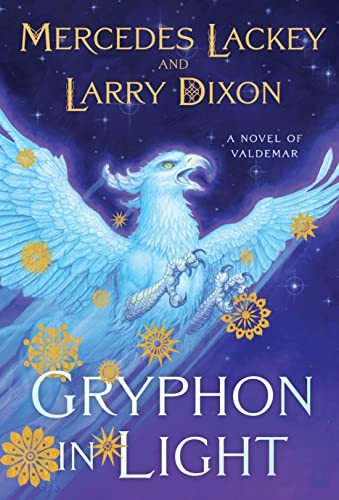
Gryphon in Light, by Mercedes Lackey and Larry Dixon
Mercedes Lackey teams up with her husband and co-writer Larry Dixon to carry the story of Valdemar and its neighboring land beyond the events of the Owl Mage (Darian) trilogy. Gryphon in Light picks up several years after Owlknight. The titular gryphon is Kelvren, an engaging, charismatic, and enthusiastic gryphon who currently serves as the leader of the gryphon guards at the diplomatic enclave of k'Valdemar. The book is entertaining, and I loved seeing Kelvren and several other familiar and beloved characters. If you're new to the series, this is not the place to jump into the Valdemar books, but if you're already a fan, read on!
#book review#my reviews#mercedes lackey#larry dixon#valdemar#valdemar series#kelvren's saga#Gryphon in Light
3 notes
·
View notes
Text


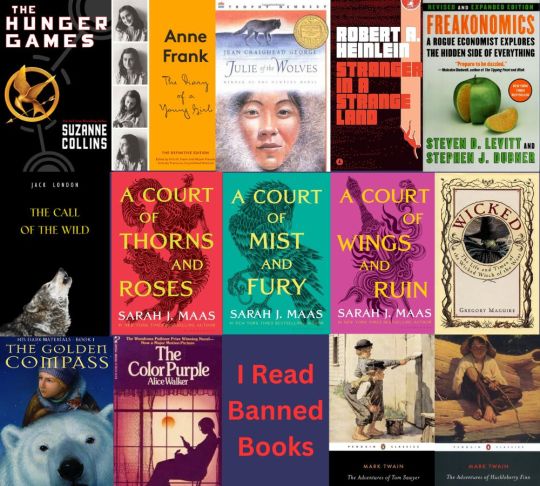
Banned Books On My Shelves
Today’s official topic is Reading Goals I Still Want to Accomplish Before the End of the Year, but this is Banned Books Week, so I’m going rogue with Banned Books On My Shelves.
All of the books on this page have been banned or challenged in schools or public libraries at some point in my lifetime. Mind you, I haven’t listed all the banned/challenged books I have read over the years, including recently; that would be a longer list. These are just the books I currently own, either in print or digital versions. I have loved some of these and consider them keepers, and I’m looking forward to reading the others.
Print books
How To Be an Antiracist (Ibram X. Kendi)
The Last Herald-Mage trilogy (Mercedes Lackey) (not pictured because I forgot to grab it off the shelf!)
To Kill a Mocking Bird (Harper Lee)
A Wrinkle in Time (Madeleine L’Engle)
The Lion, the Witch, and the Wardrobe (C. S. Lewis)
Island of the Blue Dolphins (Scot O’Dell)
Harry Potter and the Sorcerer’s Stone (J. K. Rowling) (and the whole series)
The Lord of the Rings (J. R. R. Tolkien)
The Book Thief (Markus Zuzak)
Book banners today focus on books with LGBTQIA+ content, sexually explicit books, and books that discuss race or feature BIPOC characters (Black, Indigenous, and People of Color.) Back in the ’90s and noughts, there were complaints from some conservative Christians about characters who were witches or practiced magic… hence the efforts to remove the Harry Potter books, The Lion, the Witch, and the Wardrobe, and The Lord of the Rings. (Never mind that the Narnia books are thinly disguised Christian allegory!) And of course, not all challenges come from the right; the left has challenged books which use racial slurs or contain racist attitudes, like To Kill a Mockingbird and Huckleberry Finn (listed below.)
Digital books (Kindle or audio)
The Hunger Games (Suzanne Collins)
Anne Frank: The Diary of a Young Girl (Anne Frank)
Julie of the Wolves (Jean Craighead George)
Stranger in a Strange Land (Heinlein)
Freakonomics (Levitt and Dubner)
The Call of the Wild (London)
A Court of Thorns and Roses (Maas)
A Court of Mist and Fury (Maas)
A Court of Wings and Ruin (Maas)
Wicked (Maguire)
The Golden Compass (Pullman)
The Adventures of Tom Sawyer (Twain)
The Adventures of Huckleberry Finn (Twain)
The Color Purple (Walker)
I also have digital editions of most of the books I own in print.
Do you own any banned or challenged books?
2 notes
·
View notes
Text
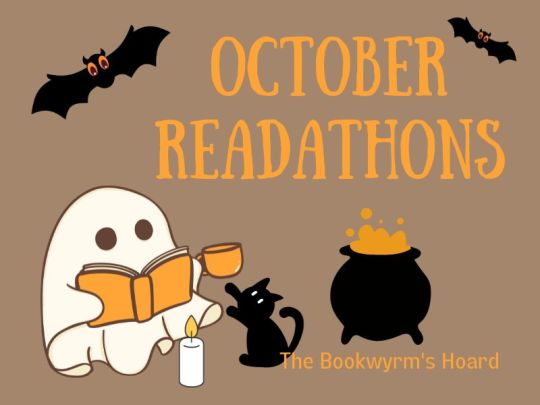
October Readathons
I’m signing up for two October readathons, in hopes they get me to read some of the books and ARCs I have:
Witchtober (the readathon, not the art challenge) is hosted by Your Book Friend, and runs from the last week of September through Halloween (Sept. 25–Oct. 31.) The idea is to read “witchy” books. They can be any genre.
Fraterfest is hosted by Kimberly at Caffeinated Reader, and runs from Thursday, Oct. 12 through Monday, Oct. 16. The idea is to read “spooky, paranormal, mysteries, thrillers and bump in the night” books. You pick your own fear level (mine is very, very mild.)
(more details on my blog)
1 note
·
View note
Text

I signed up for NaNoWriMo again this November.
I did it last year, and while I didn’t make the goal of 50,000 words in a month, I did write over 33,000 words. Granted, it wasn’t all scenes and chapters; that word count included some brainstorming and character development. But it’s still a lot of writing. I felt like I was making good progress… and then I fell of the “daily writing” wagon once our December family vacation arrived, and despite trying several times since then, I never really climbed back on. Signing up this year is a effort to kickstart myself back into writing daily.
I am announcing my participation on my blog because I need both encouragement and accountability. To be honest, just getting myself to write every day feels like battling a dragon. Self-doubt, perfectionism, and what I suspect may be ADHD combine to make it very hard for me to practice the Most Important Rule of Writing: BICHOK (“butt in chair, hands on keyboard.”) By stating my goals in public, I have more incentive to follow through.
(That's the gist, but you can read the whole post on my blog.)
2 notes
·
View notes